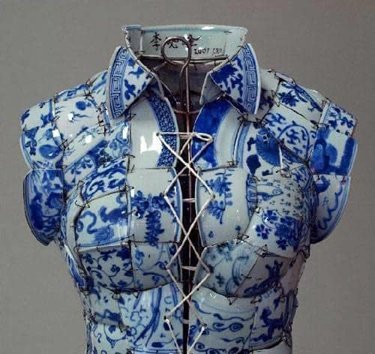Chinese Artist Makes Costumes from Antique Porcelain Shards
Armor, Art, Bizarre, China, Li Xiaofang, Porcelain
Chinese contemporary artist Li Xiaofang uses porcelain to make wearable art that pays homage to China’s past while looking toward the future. Xiaofang takes hundreds of shards of porcelain, some dating back to the Song, Ming, and Qing dynasties, and puzzles them together into magnificent porcelain dresses. His wearable art acts as both a coat of armor and a sculptural masterpiece.
Xiaofang sews together the shards using thin metal wire, and each is lined with a leather undergarment. Looking at the artist’s work, it’s impossible not to marvel at the precision and care taken, not only to find the exact shapes to form the curves of the dresses, but also how the pattern and color of the porcelain are used to create new shades and silhouettes. But Xiaofang doesn’t only limit himself to porcelain dresses, he’s also experimented with creating suit jackets, pants, blouses, and even a military hat.
The Beijing-based artist has seen his work exhibited at the Metropolitan Museum of Art and has engaged in collaborations with fashion giants like Lacoste and Alexander McQueen. A visionary in his field, his work was by the rapid development engulfing Beijing. “These blue shards, bathed in the sunny skies of socialism and caressed by the contemporary cool breezes blowing from the west throughout the capital, assume a bewildering array of postures as fashion items entering the new century,†the artist once stated. “These are the blue-and-white costumes! These emanate the splendor once crushed! These are the illusions flowing with sorrow!â€







